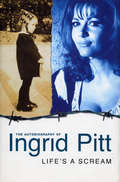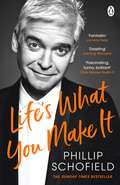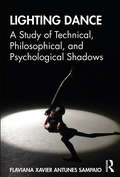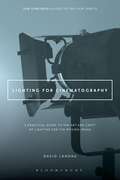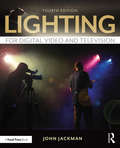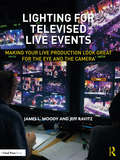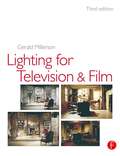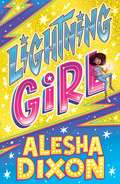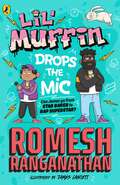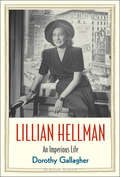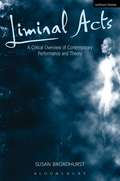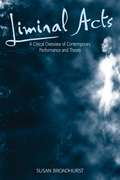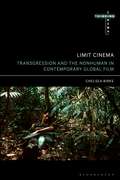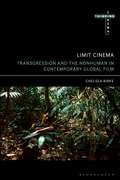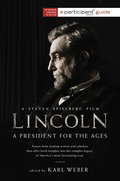- Table View
- List View
Life's A Scream: Autobiography Of Ingrid Pitt
by Ingrid PittAt the age of five, Ingrid Pitt found herself in a concentration camp. Ingrid and her mother escaped from the guards while on a forced march and presented themselves to the partisans, unsure if they would kill them. They spent the rest of the war in the forests. Ingrid fell in love for the first time and watched in despair as British bombers flew overhead. She still cannot see the vapour trials of planes without being transported back to her childhood vigil. After the war Ingrid came to London, where she developed a career as a Hammer House of Horror movie star, but, as she proundly says, `I was always the biter, never the bitten!' She also acted in mainstream films, such as WHERE EAGLES DARE. She had a child by her first marriage and a grand passion which lead to her marrying a racing driver. They lived in Argentina for a while and were good friends of President Peron and Isabelits Peron. Ingrid even spent an evening with the embalmed body of Eva Peron. Written with great passion and warmth, this is a rare childhood memoir and the story of Hammer`s most galmorous actress. Above all, this is a story of a survivor.
Life's What You Make It: The Sunday Times Bestseller 2020
by Phillip SchofieldBe the first to discover the funny, uplifting, occasionally heartbreaking and always honest life story of Phillip Schofield.'Fascinating' TIM PEAKEFor forty years we've watched Phillip on our tellies, from children's TV to This Morning and Dancing on Ice, but what is it like on set and who is he when the camera's off?In Life's What You Make It Philip for the first time takes us behind the scenes of his remarkable career.From his idyllic childhood in Cornwall, where for years he pestered the BBC for a job, eventually landing a prize position in the Broom Cupboard with mischievous sidekick Gordon the Gopher, through hosting Going Live!, starring in Joseph and the Amazing Technicolour Dreamcoat and finally finding his on-screen home and presenting-partner Holly Willoughby on This Morning, Phillip takes us on the highs and lows of his extraordinary life. ____'For a long time, I felt that I couldn't write this book. At first, I didn't think I'd lived enough, then life got busy and filled with distractions. In more recent years, there was always a very painful consideration - I knew where it would eventually have to go. 'I have recently decided that the truth is the only thing that can set me free. The truth has taken a long time to make itself clear to me, but now is the right time to share it, all of it.'Television and broadcasting has been a part of my DNA for as long as I can remember. As a young boy I would make model TV sets out of cardboard boxes, while spending long summers at home, barefoot on Cornwall's golden beaches. Landing a job at the ice-cream kiosk, I would enviously look on as my presenting heroes took to the stage of Radio 1's Roadshow, an unforgettable event when it came to town.'In Life's What You Make It I look back with nostalgic delight on my life, from being a young boy endlessly writing letters to the BBC in pursuit of a job in broadcasting, to making it on to the Broom Cupboard, with my infamous sidekick Gordon the Gopher, to being on Going Live and starring as the lead in Lord Andrew Lloyd Webber's Joseph and the Amazing Technicolour Dreamcoat. It has taken four decades to get here but I feel lucky to have called the sets of Talking Telephone Numbers, The Cube, Dancing on Ice and of course, This Morning, home.'I'm going to take you behind the scenes of my television home at ITV, into my career and my dangerously funny relationship with Holly Willoughby. I'm going to introduce you to my loving and remarkable family, and I hope most of all to tell you that life, it seems, is what you make it. Take it from someone who has sat on the very edge and looked over, it's all about the people that love you, and after that anything is possible. So, finally, here we go, this is the real me.'____ 'A really smashing book' Michael Ball'[A] fantastic read on such an interesting life' Lorraine Kelly
Life's Work: A Memoir of Storytelling and Self-Destruction
by David Milch'Illuminating . . . there is never a dull moment' - The Times'Marvellous . . . full of riches' - New StatesmanDavid Milch is the critically acclaimed writer of the iconic TV series Deadwood and NYPD Blue. As he descends into a dementia from which there's no return, Life's Work is his account of his increasingly strange present and his often painful past.Betting on race horses and stealing booze at eight years old, mentored by Robert Penn Warren and excoriated by Richard Yates at twenty-one, Milch never did anything by half. He got into Yale Law School only to be expelled for shooting out streetlights. He paused his studies at the Iowa Writers' Workshop to manufacture acid. He created some of the most lauded television series of all time, started a family and pursued sobriety, only to lose his fortune betting on the horses – just as his successful but drug-addicted father had taught him.Like Milch's best screenwriting, Life's Work explores how chance encounters, self-deception and luck shape the people we become, and wrestles with what it means to have felt and caused pain, even and especially to those we love, and how you then keep living. A compelling masterclass on Milch's unique creative process, this is a distinctive, revelatory memoir from one of the great American writers, and quite possibly his final dispatch to us all._____'Funny, discursive, literate, druggy, self-absorbed . . . You finish feeling you've really met someone' - The New York Times'A searing, brutally honest memoir' - The Independent
Light and Shade: Conversations with Jimmy Page
by Brad TolinskiJimmy Page was the leader, mastermind, guitarist and producer of Led Zeppelin, described by Rolling Stone magazine as "the biggest band of the seventies" and "unquestionably one of the most enduring bands in rock history." While there is no shortage of written material out there on Led Zeppelin's legacy, none of the band members have ever written a tell-all book or co-operated with the press or a biographer. For the most part, their exploits are merely the stuff of legend. On the rare occasions that Page has opened his doors to journalists, he has done so with caution. Over the last twenty years, Brad Tolinski, editor-in-chief of Guitar World magazine, has interviewed Page more than any other journalist in the world and by asking incisive questions, he's been able to gain the trust of this greatly misunderstood artist. Sifting through over fifty hours of conversations that touch on everything from the 1960s music scene and his early years as England's top session guitarist working with artists like The Who, The Kinks, and Eric Clapton, to his wild years in Led Zeppelin, and post-Zep projects, Light & Shade will provide readers with the most complete picture of the media-shy guitarist ever published.
A Light in the Dark: A History of Movie Directors
by David ThomsonIn little more than a century of cinema - Birth of a Nation was one hundred years old in 2015 - our sense of what a film director is, or should be, has shifted in fascinating ways. A director was once a functionary; then an important but not decisive part of an industrial process; then accepted as the person who was and should be in charge, because he was an artist and a hero. But the world has changed. In a nutshell, the change takes the form of a question: Who directed The Sopranos or Homeland? Hardly anyone knows, because we don't tend to read TV credits and the director has returned to a more subservient and anonymous role. Directors now try to be efficient, the deliverers of profitable films, and are often involved as producers, like Steven Spielberg.David Thomson's brilliant A Light in the Dark personalises each chapter through an individual: Jean Renoir, Howard Hawks, Jean-Luc Godard, Alfred Hitchcock, Luis Bunuel, Orson Welles, Fritz Lang, Jane Campion, Stephen Frears and Quentin Tarantino. Through these characters (and other directors not mentioned here), David Thomson relates an imaginative new history of a medium that has changed the world.
A Light That Never Goes Out: The Enduring Saga of the Smiths
by Tony FletcherTo this day, they were, their fans believe, the best band in the world. Critics and sales figures told a similar story. Yet for all their brilliance and adoration – their famously energetic live shows routinely interrupted by stage invasions – The Smiths were continually plagued by their reticence to play the game, and by the time of 1987’s Strangeways Here We Come, they had split. Tony Fletcher’s A Light That Never Goes Out – part celebration, part paean – moves from Manchester in the nineteenth-century to the present day to tell the complete story of The Smiths. The product of extensive research and unprecedented access, it will serve to confirm The Smiths as one of the most important and influential rock groups of all time.
Lighting Dance: A Study of Technical, Philosophical, and Psychological Shadows
by Flaviana Xavier SampaioLighting Dance pioneers the discussion of the ability of lighting design to foreground shadow in dance performances. Through a series of experiments integrating light, shadow, and improvised dance movement, it highlights and analyses what it advances as an innovative expression of shadow in dance as an alternative to more conventional approaches to lighting design. Different art forms, such as painting, film, and dance pieces from Loie Fuller, the Russell Maliphant Dance Company, Elevenplay, Pilobolus, and the Tao Dance Theater served to inspire and contextualise the study. From lighting to psychology, from reviews to academic books, shadows are examined as a symbolic and manipulative entity. The book also presents the dance solo Sombreiro, which was created to echo the experiments with light, shadow, and movement aligned to an interpretation of cultural shadow (Jung 1954, in Samuels, Shorter, and Plaut 1986; Casement 2006; Ramos 2004; Stein 2004; and others). The historical development of lighting within dance practices is also outlined, providing a valuable resource for lighting designers, dance practitioners, and theatre goers interested in the visuality of dance performances.
Lighting Dance: A Study of Technical, Philosophical, and Psychological Shadows
by Flaviana Xavier SampaioLighting Dance pioneers the discussion of the ability of lighting design to foreground shadow in dance performances. Through a series of experiments integrating light, shadow, and improvised dance movement, it highlights and analyses what it advances as an innovative expression of shadow in dance as an alternative to more conventional approaches to lighting design. Different art forms, such as painting, film, and dance pieces from Loie Fuller, the Russell Maliphant Dance Company, Elevenplay, Pilobolus, and the Tao Dance Theater served to inspire and contextualise the study. From lighting to psychology, from reviews to academic books, shadows are examined as a symbolic and manipulative entity. The book also presents the dance solo Sombreiro, which was created to echo the experiments with light, shadow, and movement aligned to an interpretation of cultural shadow (Jung 1954, in Samuels, Shorter, and Plaut 1986; Casement 2006; Ramos 2004; Stein 2004; and others). The historical development of lighting within dance practices is also outlined, providing a valuable resource for lighting designers, dance practitioners, and theatre goers interested in the visuality of dance performances.
Lighting for Cinematography: A Practical Guide to the Art and Craft of Lighting for the Moving Image (The CineTech Guides to the Film Crafts)
by David LandauWe can't shoot good pictures without good lighting, no matter how good the newest cameras are. Shooting under available light gives exposure, but lacks depth, contrast, contour, atmosphere and often separation. The story could be the greatest in the world, but if the lighting is poor viewers will assume it's amateurish and not take it seriously. Feature films and TV shows, commercials and industrial videos, reality TV and documentaries, even event and wedding videos tell stories. Good lighting can make them look real, while real lighting often makes them look fake.Lighting for Cinematography, the first volume in the new CineTech Guides to the Film Crafts series, is the indispensable guide for film and video lighting. Written by veteran gaffer and cinematographer David Landau, the book helps the reader create lighting that supports the emotional moment of the scene, contributes to the atmosphere of the story and augments an artistic style. Structured to mimic a 14 week semester, the chapters cover such things as lighting for movement, working with windows, night lighting, lighting the three plains of action and non-fiction lighting. Every chapter includes stills, lighting diagrams and key advice from professionals in the field, as well as lighting exercises to help the reader put into practice what was covered.www.lightingforcinematography.com
Lighting for Cinematography: A Practical Guide to the Art and Craft of Lighting for the Moving Image (The CineTech Guides to the Film Crafts)
by David LandauWe can't shoot good pictures without good lighting, no matter how good the newest cameras are. Shooting under available light gives exposure, but lacks depth, contrast, contour, atmosphere and often separation. The story could be the greatest in the world, but if the lighting is poor viewers will assume it's amateurish and not take it seriously. Feature films and TV shows, commercials and industrial videos, reality TV and documentaries, even event and wedding videos tell stories. Good lighting can make them look real, while real lighting often makes them look fake.Lighting for Cinematography, the first volume in the new CineTech Guides to the Film Crafts series, is the indispensable guide for film and video lighting. Written by veteran gaffer and cinematographer David Landau, the book helps the reader create lighting that supports the emotional moment of the scene, contributes to the atmosphere of the story and augments an artistic style. Structured to mimic a 14 week semester, the chapters cover such things as lighting for movement, working with windows, night lighting, lighting the three plains of action and non-fiction lighting. Every chapter includes stills, lighting diagrams and key advice from professionals in the field, as well as lighting exercises to help the reader put into practice what was covered.www.lightingforcinematography.com
Lighting for Digital Video and Television
by John JackmanThis book gives a comprehensive overview of lighting equipment and techniques for digital production. Suitable for either beginners or more advanced users, the fully updated fourth edition covers human sight vs. film or video, the basic issues of contrast and exposure, with explanation of how exposure of digital video differs from analog video or film, electrical connectors, requirements, electrical load management, safety issues, and the latest LED systems.A variety of basic lighting setups for different situations are explained, with clear diagrams and photos showing the "look" of each approach. Techniques for shooting in available light and dealing with color problems in mixed lighting situations is examined. More advanced film-style lighting is covered, especially techniques in creating a convincing realistic look. A special section deals with solutions to common problems, ranging from reflections on glasses and dealing with white walls, to lighting very light-skinned and very dark-skinned subjects in the same shot. Special lighting situations, such as lighting night scenes or bluescreen sets, are covered in detail, with studio lighting covered in a dedicated separate chapter. The book is also peppered with anecdotes and trivia about lighting techniques and the lighting trade. It is the ideal text for both beginners studying lighting and cinematography, as well as more advanced practitioners.
Lighting for Digital Video and Television
by John JackmanThis book gives a comprehensive overview of lighting equipment and techniques for digital production. Suitable for either beginners or more advanced users, the fully updated fourth edition covers human sight vs. film or video, the basic issues of contrast and exposure, with explanation of how exposure of digital video differs from analog video or film, electrical connectors, requirements, electrical load management, safety issues, and the latest LED systems.A variety of basic lighting setups for different situations are explained, with clear diagrams and photos showing the "look" of each approach. Techniques for shooting in available light and dealing with color problems in mixed lighting situations is examined. More advanced film-style lighting is covered, especially techniques in creating a convincing realistic look. A special section deals with solutions to common problems, ranging from reflections on glasses and dealing with white walls, to lighting very light-skinned and very dark-skinned subjects in the same shot. Special lighting situations, such as lighting night scenes or bluescreen sets, are covered in detail, with studio lighting covered in a dedicated separate chapter. The book is also peppered with anecdotes and trivia about lighting techniques and the lighting trade. It is the ideal text for both beginners studying lighting and cinematography, as well as more advanced practitioners.
Lighting for Televised Live Events: Making Your Live Production Look Great for the Eye and the Camera
by James L. Moody Jeff RavitzLighting for Televised Live Events unlocks the science, art, philosophies, and language of creating lighting for live entertainment and presentations that work for the television camera as well as for the live audience. The book explores how to retain the essence and excitement of a live production while assuring that the show looks its best on-camera for the millions of viewers that can only see it on their TV, computer, tablet, or mobile phone screen. Readers will learn how to adapt an existing stage show for the camera, as well as how to design live entertainment or events specifically for TV. Filled with real-life examples and illustrations, the book covers a wide range of topics, including: how exposure and color work for the camera; how angle, visual balance, and composition can make people and backgrounds look their best, while preserving theatricality; information on camera equipment, screens, and projectors, as well as the control room environments that are found on a professional shoot; the unique challenges of lighting for the IMAG video screens used at festivals and concerts. Lighting for Televised Live Events is aimed at lighting design students, as well as professional designers that are considering a career — or a career expansion — in television. It is an essential resource for any stage lighting designer whose show may be shot for a television special or a live webcast and who will be asked by their client to collaborate with the incoming video team.
Lighting for Televised Live Events: Making Your Live Production Look Great for the Eye and the Camera
by James L. Moody Jeff RavitzLighting for Televised Live Events unlocks the science, art, philosophies, and language of creating lighting for live entertainment and presentations that work for the television camera as well as for the live audience. The book explores how to retain the essence and excitement of a live production while assuring that the show looks its best on-camera for the millions of viewers that can only see it on their TV, computer, tablet, or mobile phone screen. Readers will learn how to adapt an existing stage show for the camera, as well as how to design live entertainment or events specifically for TV. Filled with real-life examples and illustrations, the book covers a wide range of topics, including: how exposure and color work for the camera; how angle, visual balance, and composition can make people and backgrounds look their best, while preserving theatricality; information on camera equipment, screens, and projectors, as well as the control room environments that are found on a professional shoot; the unique challenges of lighting for the IMAG video screens used at festivals and concerts. Lighting for Televised Live Events is aimed at lighting design students, as well as professional designers that are considering a career — or a career expansion — in television. It is an essential resource for any stage lighting designer whose show may be shot for a television special or a live webcast and who will be asked by their client to collaborate with the incoming video team.
Lighting for TV and Film
by Gerald MillersonSkilful lighting involves a subtle blend of systematic mechanics and a sensitive visual imagination. It requires anticipation, perceptiveness, patience and know-how. But learning through practice alone can take a great deal of time. This book is a distillation of many years' experience, with advice and guidance that will bring successful results right from the start. Whether you are a student studying lighting techniques in the television, video and film media, or a professional lighting for the camera, this book will be an invaluable aid. Other members of the production team, including camera crews, designers and directors, will also find the information here interesting and useful.The book concentrates primarily on the fundamental principles of lighting in studios, on location and display, as well as single-camera, small unit production, improvised and economy lighting, and working with limited facilities. Emphasis is also placed on the safety aspects of working with lighting equipment.Lighting for Television and Film reflects the author's considerable experience of lighting techniques in BBC studios, his teaching and consultancy work.Gerald Millerson's analytical writings spring from a lifetime's personal experience in the medium, and from his teaching and engineering background. During his career with the BBC, he was primarily associated with studio operations in the Television Service. His lecturing background included courses in TV production at a number of American universities.His other books for Focal Press are Television Production, TV Scenic Design, Video Production Handbook and, in the Media Manuals series, Effective TV Production, Lighting for Video and Video Camera Techniques.
Lighting for TV and Film (Library Of Communication Techniques Ser.)
by Gerald MillersonSkilful lighting involves a subtle blend of systematic mechanics and a sensitive visual imagination. It requires anticipation, perceptiveness, patience and know-how. But learning through practice alone can take a great deal of time. This book is a distillation of many years' experience, with advice and guidance that will bring successful results right from the start. Whether you are a student studying lighting techniques in the television, video and film media, or a professional lighting for the camera, this book will be an invaluable aid. Other members of the production team, including camera crews, designers and directors, will also find the information here interesting and useful.The book concentrates primarily on the fundamental principles of lighting in studios, on location and display, as well as single-camera, small unit production, improvised and economy lighting, and working with limited facilities. Emphasis is also placed on the safety aspects of working with lighting equipment.Lighting for Television and Film reflects the author's considerable experience of lighting techniques in BBC studios, his teaching and consultancy work.Gerald Millerson's analytical writings spring from a lifetime's personal experience in the medium, and from his teaching and engineering background. During his career with the BBC, he was primarily associated with studio operations in the Television Service. His lecturing background included courses in TV production at a number of American universities.His other books for Focal Press are Television Production, TV Scenic Design, Video Production Handbook and, in the Media Manuals series, Effective TV Production, Lighting for Video and Video Camera Techniques.
Lightning Girl
by Alesha DixonHigh-voltage fiction from a top TV judge! When life gets dark, can Aurora save the world with her totally _flash_ superpowers? Aurora Beam is utterly (yawn) normal. There's nothing special about her. She can't even do a proper cartwheel. That is, until the day she spots a bully picking on her little sis - and sparks suddenly fly! Seriously: there are beams of light shooting out of Aurora's fingers. What's going on? That's when Mum drops a life-changing bombshell. She's a secret superhero - and now it's time for Aurora to join the crusade against crime!
Like Father, Like Son: A family story
by Michael ParkinsonA look at the life and times of the man Sir Michael most looked up to.It started in the shadow of the pithead in a South Yorkshire mining village and ended up in tears before an audience of millions. Michael Parkinson's relationship with his late father John William was, and remains, a family love story overflowing with tenderness and tall tales of sporting valour, usually involving Yorkshire cricket or Barnsley FC. However, it was the overwhelming grief which poured out of Michael when Piers Morgan pressed him about John William in a television interview - four decades after the death of the father he encapsulated as 'Yorkshireman, miner, humorist and fast bowler' - that convinced one of the outstanding broadcasters and journalists of our time to delve deeper into the dynamics of their lives together. Co-written with his son Mike, this affectionate and revealing memoir explores the influences which shaped John William, Michael and succeeding generations of Parkinsons. The journey leads them from the depths of a Yorkshire coal mine, via the chapel, pub and picture-house, to a spot behind the bowler's arm at Lord's and the sands at Scarborough. While Like Father, Like Son conveys a powerful sense of time and place, it is wit, insight and, above all, enduring love which shine through its pages.
Lil' Muffin Drops the Mic: The brand-new children’s book from comedian Romesh Ranganathan!
by Romesh RanganathanFrom comedy superstar Romesh Ranganathan comes a hilarious and heartfelt tale that proves rap battles and baking muffins really can mix. The perfect story for readers age 8+ and fans of David Baddiel and Adam B Wins the Internet!Ever since his dad left, James can't seem to stop worrying about everything. His favourite hobby, baking, is a fun (and delicious!) distraction, but no matter how many AMAZING brownies he makes, James still feels like there's a missing ingredient in his life . . .Until he discovers rapping, and he's COMPLETELY hooked. It's not long before James starts writing his own raps about everything - from music and cakes to his giant pet rabbit, Graham!So when he hears that grime artist star Brukka is on the hunt for young talent, James starts to wonder: could this be his chance to share his MUFFINS, his MUSIC, and maybe even his feelings with the whole school? If he could only find the confidence . . .Full of laugh-out-loud illustrations from bestselling illustrator James Lancett, this is the children's read of the summer!
Lillian Hellman: An Imperious Life (Jewish Lives)
by Dorothy GallagherGlamorous, talented, audacious—Lillian Hellman knew everyone, did everything, had been everywhere. By the age of twenty-nine she had written The Children’s Hour, the first of four hit Broadway plays, and soon she was considered a member of America’s first rank of dramatists, a position she maintained for more than twenty-five years. Apart from her literary accomplishments—eight original plays and three volumes of memoirs—Hellman lived a rich life filled with notable friendships, controversial political activity, travel, and love affairs, most importantly with Dashiell Hammett. But by the time she died, the truth about her life and works had been called into question. Scandals attached to her name, having to do with sex, with money, and with her own veracity. Dorothy Gallagher confronts the conundrum that was Lillian Hellman—a woman with a capacity to inspire outrage as often as admiration. Exploring Hellman’s leftist politics, her Jewish and Southern background, and her famous testimony before the House Un-American Activities Committee, Gallagher also undertakes a new reading of Hellman’s carefully crafted memoirs and plays, in which she is both revealed and hidden. Gallagher sorts through the facts and the myths, arriving at a sharply drawn portrait of a woman who lived large to the end of her remarkable life and never backed down from a fight.
Liminal Acts: A Critical Overview of Contemporary Performance and Theory
by Susan BroadhurstThe term liminal refers to a marginalized space of fertile chaos and creative potential where nothing is fixed or certain. Liminal performance is an emerging genre which has surfaced only in recent times and describes a range of interdisciplinary, highly experimental, performative works in theatre and performance, film and music-performances which can be seen to prioritize the body, the technological and the primordial. Broadhurst argues that traditional and contemporary critical and aesthetic theories are ultimately deficient in interpreting liminal performance. This revolutionary work first surveys traditional aesthetics in the writings of Kant, Nietzsche and Heidegger and juxtaposes them with contemporary aesthetics in the writings of Foucault, Derrida, Baudrillard and Lyotard. A series of case studies follows and, Broadhurst concludes with a summary description of liminal performances as an emerging genre. Works discussed in detail include: Pina Bausch's Tanztheater, the innovative Theatre of Images of Robert Wilson and Philip Glass, the controversial social sculptures of the Viennese Actionists, Peter Greenaway's painterly aesthetics, Derek Jarman's queer politics, digitized sampled music, and neo-gothic sound.
Liminal Acts: A Critical Overview of Contemporary Performance and Theory
by Susan BroadhurstThe term liminal refers to a marginalized space of fertile chaos and creative potential where nothing is fixed or certain. Liminal performance is an emerging genre which has surfaced only in recent times and describes a range of interdisciplinary, highly experimental, performative works in theatre and performance, film and music-performances which can be seen to prioritize the body, the technological and the primordial. Broadhurst argues that traditional and contemporary critical and aesthetic theories are ultimately deficient in interpreting liminal performance. This revolutionary work first surveys traditional aesthetics in the writings of Kant, Nietzsche and Heidegger and juxtaposes them with contemporary aesthetics in the writings of Foucault, Derrida, Baudrillard and Lyotard. A series of case studies follows and, Broadhurst concludes with a summary description of liminal performances as an emerging genre. Works discussed in detail include: Pina Bausch's Tanztheater, the innovative Theatre of Images of Robert Wilson and Philip Glass, the controversial social sculptures of the Viennese Actionists, Peter Greenaway's painterly aesthetics, Derek Jarman's queer politics, digitized sampled music, and neo-gothic sound.
Limit Cinema: Transgression and the Nonhuman in Contemporary Global Film (Thinking Cinema)
by Chelsea BirksLimit Cinema explores how contemporary global cinema represents the relationship between humans and nature. During the 21st century this relationship has become increasingly fraught due to proliferating social and environmental crises; recent films from Lars von Trier's Melancholia (2011) to Apichatpong Weerasethakul's Uncle Boonmee Who Can Recall His Past Lives (2010) address these problems by reflecting or renegotiating the terms of our engagement with the natural world. In this spirit, this book proposes a new film philosophy for the Anthropocene. It argues that certain contemporary films attempt to transgress the limits of human experience, and that such 'limit cinema' has the potential to help us rethink our relationship with nature. Posing a new and timely alternative to the process philosophies that have become orthodox in the fields of film philosophy and ecocriticism, Limit Cinema revitalizes the philosophy of Georges Bataille and puts forward a new reading of his notion of transgression in the context of our current environmental crisis. To that end, Limit Cinema brings Bataille into conversation with more recent discussions in the humanities that seek less anthropocentric modes of thought, including posthumanism, speculative realism, and other theories associated with the nonhuman turn. The problems at stake are global in scale, and the book therefore engages with cinema from a range of national and cultural contexts. From Ben Wheatley's psychological thrillers to Nettie Wild's eco-documentaries, limit cinema pushes against the boundaries of thought and encourages an ethical engagement with perspectives beyond the human.
Limit Cinema: Transgression and the Nonhuman in Contemporary Global Film (Thinking Cinema)
by Chelsea BirksLimit Cinema explores how contemporary global cinema represents the relationship between humans and nature. During the 21st century this relationship has become increasingly fraught due to proliferating social and environmental crises; recent films from Lars von Trier's Melancholia (2011) to Apichatpong Weerasethakul's Uncle Boonmee Who Can Recall His Past Lives (2010) address these problems by reflecting or renegotiating the terms of our engagement with the natural world. In this spirit, this book proposes a new film philosophy for the Anthropocene. It argues that certain contemporary films attempt to transgress the limits of human experience, and that such 'limit cinema' has the potential to help us rethink our relationship with nature. Posing a new and timely alternative to the process philosophies that have become orthodox in the fields of film philosophy and ecocriticism, Limit Cinema revitalizes the philosophy of Georges Bataille and puts forward a new reading of his notion of transgression in the context of our current environmental crisis. To that end, Limit Cinema brings Bataille into conversation with more recent discussions in the humanities that seek less anthropocentric modes of thought, including posthumanism, speculative realism, and other theories associated with the nonhuman turn. The problems at stake are global in scale, and the book therefore engages with cinema from a range of national and cultural contexts. From Ben Wheatley's psychological thrillers to Nettie Wild's eco-documentaries, limit cinema pushes against the boundaries of thought and encourages an ethical engagement with perspectives beyond the human.
Lincoln: A President for the Ages (A\participant Media Guide Ser.)
by Participant MediaThe First American. Frontiersman and backwoods attorney. Teller of bawdy tales and a spellbinding orator. A champion of liberty some called a would-be tyrant. Savior of the Union and the Great Emancipator. All these are Abraham Lincoln-in his time America's most admired and reviled leader, and still our nation's most enigmatic and captivating hero.Timed to complement the new motion picture Lincoln, directed by Steven Spielberg, Lincoln: A President for the Ages introduces a new Lincoln grappling with some of history's greatest challenges. Would Lincoln have dropped the bomb on Hiroshima? How would he conduct the War on Terror? Would he favor women's suffrage or gay rights? Would today's Lincoln be a star on Facebook and Twitter? Would he embrace the religious right-or denounce it?The answers come from an all-star array of historians and scholars, including Jean Baker, Richard Carwardine, Dan Farber, Andrew Ferguson, Henry Louis Gates Jr., Allen C. Guelzo, Harold Holzer, James Malanowski, James Tackach, Frank J. Williams, and Douglas L. Wilson. Lincoln also features actor/activist Gloria Reuben describing how she played Elizabeth Keckley, the former-slave-turned-confidante of First Lady Mary Todd Lincoln; and a selection of speeches and letters that explore little-known sides of Lincoln; "The Faces of Lincoln,” exploring his complex contemporary legacy.Whether you're a lifetime admirer of Lincoln or newly intrigued by his story, Lincoln: A President for the Ages offers a fascinating glimpse of his many-sided legacy.
